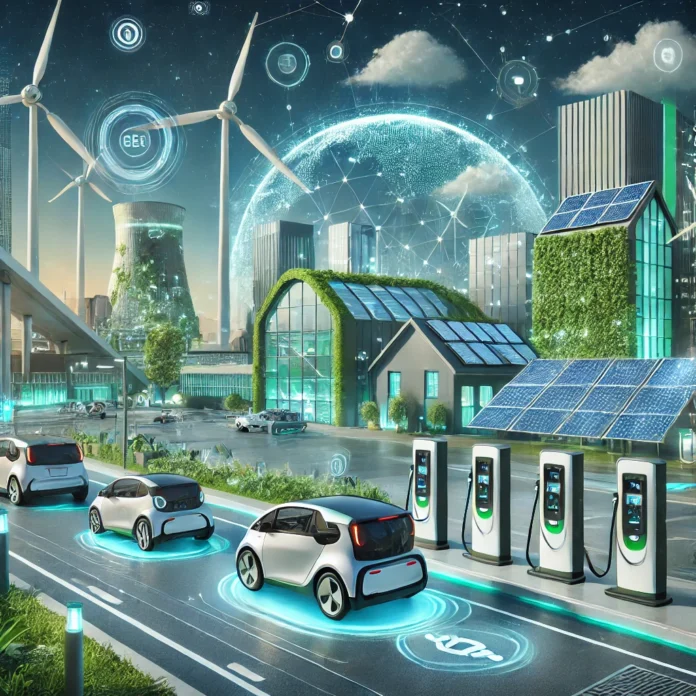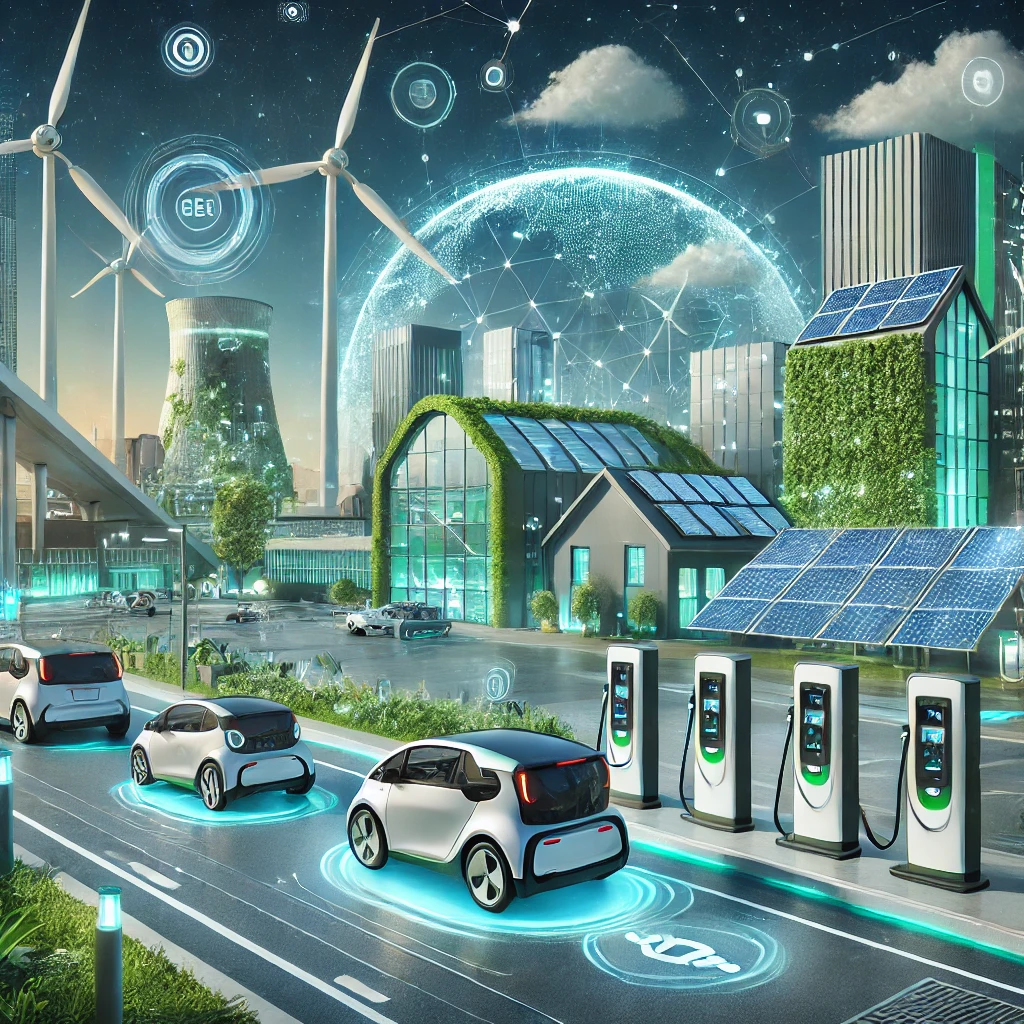
In an era where climate change and environmental degradation are at the forefront of global concerns, the technology sector is making significant strides toward sustainability. From renewable energy innovations to electric vehicles and energy-efficient gadgets, the move toward eco-friendly technology is reshaping industries, consumer habits, and our relationship with the planet. Let’s quickly dive into how sustainable technology is driving the shift to a greener, more sustainable future.
1. Renewable Energy: Powering the World with Clean Energy

The global reliance on fossil fuels for energy has led to significant carbon emissions, contributing to global warming and environmental degradation. In response, renewable energy technologies have emerged as critical solutions to reduce carbon footprints and transition to more sustainable energy sources. Solar, wind, hydropower, and geothermal energy are leading the way in this transformation.
1.1. Solar Power: Harnessing the Sun’s Energy
One of the most well-known renewable energy sources is solar power. Solar panels, which convert sunlight into electricity, have become increasingly popular as the technology has become more affordable and efficient. Photovoltaic (PV) cells, which make up solar panels, have seen improvements in efficiency, allowing them to generate more electricity from the same amount of sunlight.
Key innovations in solar energy include:
- Perovskite solar cells: These next-generation solar cells offer higher efficiency and lower production costs compared to traditional silicon-based cells. They can be used in flexible and lightweight applications, making them ideal for integrating solar technology into buildings, vehicles, and even clothing.
- Solar farms: Large-scale solar farms are being developed around the world to provide clean energy to entire communities and industries. These farms generate vast amounts of electricity, reducing the reliance on coal and gas power plants.
- Solar storage: Advancements in energy storage technology, particularly in batteries, are making it possible to store solar energy for use during cloudy days or at night. This is a significant step toward making solar energy a more reliable and consistent power source.
1.2. Wind Energy: Harnessing the Power of the Wind
Wind power is another key player in the renewable energy landscape. Wind turbines, both onshore and offshore, convert the kinetic energy from wind into electricity. Over the years, turbines have become more efficient and larger in scale, allowing them to generate more energy from lower wind speeds.
- Offshore wind farms are particularly promising, as they can harness stronger and more consistent winds found over oceans and large lakes. Countries like the UK, Germany, and Denmark are leading the way in offshore wind energy production.
- Floating wind turbines are an emerging technology that allows for wind farms to be built in deeper waters where traditional turbines cannot be anchored. These turbines can access stronger winds further from shore, making them a game-changer for wind energy potential.
1.3. Hydropower and Geothermal Energy
While solar and wind are leading the renewable energy charge, hydropower and geothermal energy also play essential roles in the sustainable energy mix.
- Hydropower generates electricity by using the flow of water, typically from dams. It is one of the oldest and most established forms of renewable energy, providing a reliable source of power.
- Geothermal energy taps into the Earth’s internal heat to generate electricity or provide direct heating for homes and businesses. Countries like Iceland, which sits on a tectonic hotspot, are pioneers in geothermal energy use.
2. Electric Vehicles: Revolutionizing Transportation
The transportation sector is one of the largest contributors to global greenhouse gas emissions, primarily due to the reliance on gasoline and diesel-powered vehicles. Electric vehicles (EVs) have emerged as a key solution to this problem, offering zero-emission alternatives to traditional internal combustion engines.
2.1. The Growth of Electric Vehicles
Electric vehicles have gained significant momentum in recent years, thanks to advances in battery technology, government incentives, and growing environmental awareness. Leading automakers such as Tesla, General Motors, and Nissan have developed a wide range of electric cars that are increasingly accessible to the average consumer.
- Battery technology: The key to the growth of EVs is the improvement in lithium-ion batteries, which are lighter, more efficient, and capable of holding more charge than ever before. Research is also being conducted on solid-state batteries, which promise even greater energy density and faster charging times.
- Charging infrastructure: As the demand for EVs grows, so does the need for more extensive charging infrastructure. Fast-charging stations are becoming more widespread, allowing EV owners to recharge their vehicles in a matter of minutes, rather than hours.
- Electric trucks and buses: Beyond passenger vehicles, electric trucks and buses are becoming more common in commercial transportation. Companies like Rivian and Nikola are developing electric trucks, while cities around the world are transitioning to electric buses to reduce pollution and improve air quality.
2.2. Autonomous and Shared Mobility
EVs are not just about reducing emissions; they are also paving the way for autonomous driving and shared mobility. These technologies, when combined with electric vehicles, can lead to a more efficient and sustainable transportation system.
- Autonomous electric vehicles could reduce traffic congestion, lower accident rates, and increase fuel efficiency by optimizing driving patterns.
- Shared mobility services, such as ride-hailing and car-sharing, can further reduce the number of vehicles on the road, decreasing overall emissions and promoting a more sustainable transportation model.
3. Energy-Efficient Gadgets: Reducing the Environmental Footprint
While large-scale renewable energy and electric vehicles are critical to tackling climate change, everyday consumers also play a role in sustainability through the use of energy-efficient gadgets. From smart home devices to energy-saving appliances, technology is helping individuals reduce their carbon footprint and lower energy consumption.
3.1. Smart Home Devices
Smart home technology allows consumers to manage their energy use more efficiently. Devices such as smart thermostats, energy-efficient lighting, and smart plugs help reduce electricity consumption by automating and optimizing power usage.
- Smart thermostats like Google Nest or Ecobee learn a homeowner’s habits and adjust the heating and cooling systems accordingly, significantly reducing energy waste.
- LED lighting is far more energy-efficient than traditional incandescent bulbs, using up to 75% less energy and lasting significantly longer.
- Smart meters allow consumers to monitor their energy use in real-time, providing insights into how and when energy is being consumed and offering tips to reduce waste.
3.2. Energy-Efficient Appliances
Beyond smart gadgets, energy-efficient appliances are playing a significant role in reducing household energy consumption. Appliances with the ENERGY STAR® rating, such as refrigerators, washing machines, and dishwashers, are designed to use less water and electricity while maintaining high performance.
- Induction stoves are an energy-efficient alternative to traditional gas or electric stovetops, using electromagnetic fields to directly heat cookware, reducing energy loss.
- Heat pump technology in water heaters and HVAC systems is another innovation that uses significantly less energy than conventional systems by transferring heat instead of generating it.
3.3. Sustainable Materials and Manufacturing
In addition to energy-efficient design, tech companies are increasingly focusing on sustainable materials and eco-friendly manufacturing processes to reduce the environmental impact of their products.
- Recycled materials: Companies like Apple and Samsung are incorporating recycled materials, such as aluminum and plastics, into their products, reducing the need for virgin materials and minimizing waste.
- E-waste recycling: The tech industry generates significant amounts of electronic waste (e-waste), but efforts are being made to recycle old devices and recover valuable materials like copper, gold, and rare earth metals.
4. The Role of Governments and Corporations
The shift to sustainable technology is not solely driven by consumer demand; government policies and corporate responsibility play crucial roles in shaping the future of eco-friendly innovations.
4.1. Government Policies and Incentives
Governments around the world are introducing policies and incentives to promote the adoption of sustainable technologies. These include:
- Subsidies and tax credits for consumers who purchase electric vehicles or install solar panels on their homes.
- Emissions regulations that require automakers to produce more fuel-efficient and lower-emission vehicles.
- Renewable energy mandates, which require utilities to source a certain percentage of their electricity from renewable sources.
4.2. Corporate Sustainability Initiatives
Many tech companies are adopting corporate sustainability goals to reduce their environmental impact. For example:
- Microsoft has pledged to become carbon negative by 2030, meaning they will remove more carbon from the environment than they emit.
- Google has committed to running its global operations entirely on renewable energy and reducing waste across its supply chain.
- Apple aims to make all of its products and packaging from 100% recycled or renewable materials.

![[Galaxy Unpacked 2025] A First Look At The Galaxy Z Fold7](https://www.techquery.ng/wp-content/uploads/2025/07/EC5C9262-C536-4F53-BAB3-5B53771FD5F6-183x150.png)











































